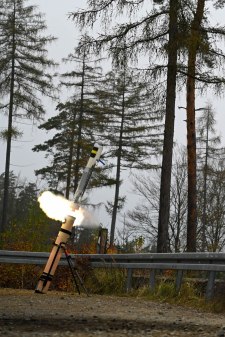Marine Corps leader keen on underwater drones that can launch loitering munitions

A top Marine Corps modernization officer expects to see U.S. military experimentation with unmanned underwater vessels that can launch kamikaze drones.
The Pentagon is pursuing a variety of uncrewed maritime systems as well as loitering munitions. But Lt. Gen. Karsten Heckl, deputy commandant for combat development and integration and commanding general of Marine Corps Combat Development Command, sees the potential to marry those types of technologies.
The Marines are already pursuing so-called one-way attack drones — also known as loitering munitions, kamikaze drones, or suicide drones because they’re designed to destroy their targets by crashing into them — for dismounted infantry as part of the service’s Force Design 2030 modernization effort.
“We’re focused very heavily now on the organic precision fires, loitering munitions. There’s a lot of areas there that I think we can accelerate because industry is clearly cutting the path for us,” Heckl said Wednesday at the annual Defense News Conference.
There’s also “the idea of loitering munitions coming off of unmanned surface vessels, loitering munitions coming out of unmanned underwater vessels, right. You can let your imagination run wild,” he added.
The U.S. military hasn’t yet tested out the concept of launching kamikaze drones from USVs or UUVs, he told DefenseScoop during a meeting with reporters on the sidelines of the conference. But doing so is part of the plan, he suggested.
“We’re not experimenting, but we will. I mean, imagine maybe it’s even a semi-submersible so if you don’t have to go deep in the water, it’s less expensive, it’s just not as complicated. But imagine a fully autonomous UUV that can go out, get to within X range of an area, surface and launch thousands of loitering munitions that are fully autonomous, and then slip back below the surface and return to an [expeditionary advanced base] to be refilled. That’s where we’re going,” he said.
DefenseScoop asked Heckl if a system like the Orca extra-large UUV could potentially perform that type of role.
“Could be. We’re certainly looking at Orca, yep. But … I try to drive cost out everything, right, because we have to be good stewards of the American taxpayers’ money. So, I don’t need a … submersible that goes down to like, you know, nuclear submarine depth. I just don’t need it. You know it’s very expensive, so that’s why the semi-submersible thing is really attractive,” he said.
Uncrewed vessels could also be used to launch torpedoes to kill enemy ships, according to Heckl.
However, there will be technical issues associated with employing weapons from USVs and UUVs, he noted. For example, loitering munitions will need to be protected from harsh maritime environments until they’re ready to be launched.
“Now you’re talking about things that have to move and open up. [And there’s] always potential for failure,” he said. “That’s why I think keeping things as simple as you can [is advantageous]. The more simple the machine, the less likely it is to break.”






